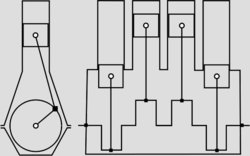Straight engine
Usually found in 4 and 6 cylinder configurations, the straight engine (often designed as inline engine) is an internal-combustion engine with all cylinders aligned in one row, with no or only minimal offset.
A straight engine is considerably easier to build than an otherwise equivalent horizontally opposed or V engine because the cylinder bank can be milled from a single metal casting and it requires fewer cylinder heads and camshafts. Inline engines are also much smaller in volume than designs like the radial, and can be mounted in any direction. Straight configurations are simpler than their V-shaped counterparts and usually provide smoother running, but at the cost of greater engine length.
Automobile use
The straight-4 is by far the most common 4 cylinder configuration, whereas the straight-6 has largely given way to the V6, which although not as naturally smooth-running is smaller in both length and height and easier to fit into the engine bay of smaller modern cars. Some manufacturers, notably Acura, Audi, Toyota, VW and Volvo Cars, have also used straight-5 configurations. The General Motors GM Atlas engine family includes straight-4, straight-5, and straight-6 engines.
Many manufacturers mount straight engines at an angle from the vertical, referring to them as slant engines. Chrysler's famous Chrysler Slant 6 engine was used in many models in the 1960s and 1970s. Honda also often mounts their straight-4 and straight-5 engines at a slant, as on the Honda S2000 and Acura_Vigor. SAAB first used an inline-4 tilted at 45 degrees for the Saab 99, but later versions of the engine were less tilted.
Two main factors have led to the recent decline of the straight-6 in automotive applications. Lanchester balance shafts, an old idea reintroduced by Mitsubishi in the 1980s to overcome the natural harshness of the straight-4 engine and rapidly adopted by many other manufacturers, have made both straight-4 and V-6 engines much more refined than used to be the case. The inherent smoothness of the straight-6 is no longer as great an advantage as it used to be. Secondly, at around the same time, fuel consumption became a much more important factor. Cars became smaller and much more space-efficient. The engine bay of a modern small or medium car, typically designed for a straight-4, often does not have room for a straight-6, but can fit a V-6 with only minor modifications. Conversely, if the car is designed to have enough room for a straight-6, the 4-cylinder version of the same car will have wasted space and, all else being equal, cost a little more to manufacture and use more fuel.
Some manufacturers (originally Lancia, and more recently Volkswagen with the VR6) have attempted to combine advantages of the straight and V configurations by producing a narrow-angle V; this is more compact than either configuration, but is less smooth (without balancing) than either.
Straight-6 engines can still be found in passenger vehicles like the Australian Ford Falcon, some entry-level Lexus models, the Toyota Landcruiser, and BMW 6-cylinder models.
Aviation use
Renault produced an inverted air-cooled Straight-6 for airplanes this was used on the Stampe. A similar design was used on the de Havilland Tiger Moth.
Automotive, aircraft and marine use
- Straight-twin
- Straight-3
- Straight-4
- Straight-5
- Straight-6
- Straight-8
- Straight-9
- Straight-10
- Straight-12
- Straight-14
- Straight-24
See also
- Flat engine
- H engine
- V engine
- W engine
- Wankel engine - Although not a piston engine, it is still an internal combustion engine.
| Piston engine configurations | |
|---|---|
| Straight | Single, 2, 3, 4, 5, 6, 8, 9, 10, 12, 14 |
| V | 2, 4, 5, 6, 8, 10, 12, 16, 20, 24 |
| Flat | 2, 4, 6, 8, 10, 12, 16, H |
| W | 8, 9, 12, 16, 18 |
| Other inline | H, VR, Opposed, U (Square), X |
| Other | Hemi, Radial, Rotary, Pistonless, Deltic, (Wankel) |
| Heat engines | |
|---|---|
| Stroke cycles One • Two • Four • Six • | |
| Engine types Gas turbine • Piston • Jet • Rocket engine • Steam engine • Stirling engine • Tschudi• Twingle Rotary • Wankel • Free-piston • Britalus • Coomber • Swing-piston • Orbital • Quasiturbine | |
| Valves Cylinder head porting • D slide • Four-stroke • Manifold • Multi • Piston • Poppet • Sleeve | |
| Piston layouts Single cylinder • Straight • Opposed • Flat • V • W • H • Deltic • Radial • Rocket engine nozzle • Rotary • Stelzer • Controlled Combustion • Bourke | |
| Motion mechanisms Cam • Connecting rod • Coomber rotary • Crank • Crank substitute • Crankshaft • Linkages (Evans • Peaucellier-Lipkin • Sector straight-line • Watt) • Double acting/differential cylinder | |
| Thermodynamic cycle |
